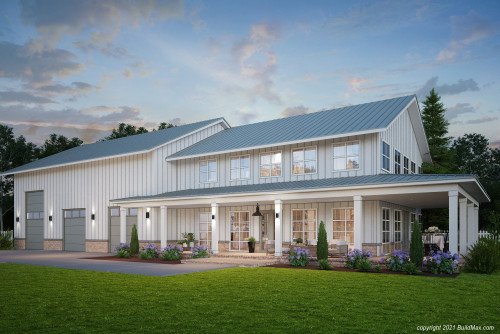Barndominiums Vs. Typical Homes: a Detailed Contrast of Way Of Life and Performance
The choice between barndominiums and traditional homes encompasses different factors, consisting of lifestyle preferences and functional requirements. Barndominiums are identified by their open formats and versatility, often attracting those who focus on communal living and versatility. On the other hand, typical homes use a more organized environment, which might better serve family members looking for personal privacy and a sense of history. As we check out the price implications and ecological factors to consider, it comes to be clear that the choice expands past simple aesthetic appeals and functionality; it invites a much deeper exploration of what genuinely defines a home.
Overview of Barndominiums
Barndominiums, a novel housing pattern gaining appeal throughout numerous areas, blend the rustic charm of barn-style design with the capability of contemporary space. These unique structures normally are composed of a steel or wood framework, integrating open layout and high ceilings with energy-efficient attributes. Typically located on extensive rural residential properties, barndominiums supply home owners the possibility to enjoy a calm lifestyle while providing adequate area for numerous tasks.
The adaptability of barndominiums prolongs past their aesthetic appeal; they can function as both living quarters and functional spaces for hobbies, workshops, or even local business. Their flexible layout enables easy customization, suiting varied family demands and choices. Several owners appreciate the reduced upkeep demands connected with metal siding and roof covering, adding to lasting toughness.

Features of Standard Residences
Emphasizing timeless layout and comfort, standard homes are defined by their distinctive building designs, which often show historic impacts and local appearances. Usual functions consist of balanced facades, gabled roof coverings, and a focus on workmanship, resulting in a warm and inviting ambience.
Standard homes usually incorporate elements such as crown molding, wainscoting, and wood floor covering, improving their classic allure. They commonly feature multiple areas with defined functions, promoting family interaction while allowing for privacy. see website. The format often includes official living and dining areas, which are favorable to entertaining guests and organizing household gatherings
Exterior products such as brick, wood, or rock are frequently utilized, contributing to resilience and a feeling of permanence. Barndominium builder. Additionally, numerous traditional homes are developed with front verandas or stoops, cultivating a feeling of community and link with the neighborhood
Landscaping plays a considerable role in standard home design, with properly maintained gardens and pathways that boost curb appeal - read more. On the whole, typical homes personify a sense of nostalgia and security, appealing to those who value heritage and a more structured living environment
Price Contrast
Generally, a cost comparison between barndominiums and conventional homes reveals significant differences in building expenses and total financial investment. Barndominiums, typically created from metal or steel frames, commonly incur lower product and labor costs than conventional homes built from timber and brick. The simplified design of barndominiums can translate to decreased building times, additionally lowering labor prices and expediting tenancy.
On standard, the price per square foot for a barndominium ranges from $100 to $150, while conventional homes can vary extensively, normally dropping between $150 and $300 per square foot, depending upon area, materials, and layout intricacy. This cost difference makes barndominiums an appealing alternative for budget-conscious buyers seeking bigger living areas without sacrificing top quality.
In addition, barndominiums may lead to lasting cost savings via lower maintenance costs, energy effectiveness, and insurance rates. Their durable building and construction materials commonly call for less upkeep gradually compared to conventional homes. It is vital to take into consideration that while initial expenses might be lower for barndominiums, the final investment will certainly also depend on individual personalization and wanted features, which can affect the general expense in both real estate types.
Lifestyle and Area Factors To Consider
When taking into consideration way of life and area, barndominiums supply a special adaptability that attract a variety of property owners. These hybrid structures combine residential coping with useful space, typically including open layout that can be adjusted to suit private requirements. This adaptability is especially helpful for families or individuals looking for an individualized living setting, permitting varied uses such as office, workshops, or recreational locations.

Additionally, the visual appeal of barndominiums can deal with both rustic and contemporary preferences, making them a functional selection for different layout preferences (Barndominium builder). Eventually, the choice in between a barndominium and a standard home commonly pivots on exactly how well each option lines up with the home owner's lifestyle goals and spatial requirements, highlighting the importance of taking into consideration personal top priorities in the decision-making procedure
Environmental Impact and Sustainability
The environmental effect and sustainability of barndominiums present compelling advantages compared to typical homes. Mainly built from steel and other long lasting products, barndominiums are typically built utilizing recycled resources, minimizing the need for new materials and reducing waste. Their style usually emphasizes open spaces, which can result in lower energy consumption for cooling and heating contrasted to conventional homes with more fractional designs.
In addition, barndominiums can include sustainable functions such as photovoltaic panels, rain harvesting systems, and advanced insulation techniques, enhancing their power effectiveness. The versatility of their style permits homeowners to integrate these innovations extra perfectly than in numerous typical homes, which may need extensive retrofitting.
Additionally, barndominiums commonly call for fewer sources for construction due to their less complex, more efficient designs (see website). Overall, barndominiums stand for a forward-thinking strategy to sustainable living, straightening with modern ecological top priorities.
Final Thought
In summary, the choice between barndominiums and standard homes hinges on individual lifestyle choices and useful demands. Barndominiums, with their open layouts and sustainable products, cater to those looking for flexibility and common living.
Comments on “Comprehensive Barndominium Repair: Taking Care Of Architectural and Visual Issues”